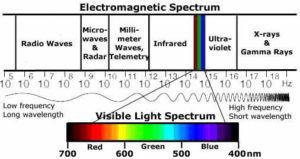by Dan Roberts
May 2008
Why wear sunglasses?
If you have a retinal disease, you are probably photosensitive, where too much direct light is painful for your eyes. You also have retinal cells that can be easily damaged by too much light, and some colors of light (even invisible light) have been shown to be hazardous. Additionally, reflected light and glare from horizontal surfaces serve only to compound your problems when you are already dealing with compromised vision.
The right sunglasses can eliminate all or most of these difficulties, allowing you to safely maximize your vision in bright environments. The endless array of choices, however, can be confounding. Hopefully, this article will help you to narrow your options and make your decisions easier.
What your sunglasses should do
1. Totally eliminate “ultraviolet” (UV) rays.
UV rays are of such high frequency that they cannot be seen by the human eye. They are short wavelengths measuring less than 400 nanometers (nm), as illustrated below.

UV rays are divided into two categories, UV-A and UV-B, with UV-A being the most intense. Your cornea absorbs all UV-B, and most UV-A. Over time, however, the UV-A that gets through can damage your lens and retina, so you want to be sure your sunglasses are labeled 100% UV-A and UV-B protective.
2. Reduce or eliminate blue light.
Blue light waves (400-500 nm) are responsible for the haze you see in bright sunlight, and a growing compendium of research is showing that this frequency can also be hazardous to the lens and retina. For a great deal of information on the effect of light on the retina, see “Artificial Lighting and the Blue Light Hazard” on this site.
To protect your eyes from blue light and to increase contrast, you need to look for specific tints:
- orange, red-orange = 100% protection (no visible blue)
- yellow, amber, gold, brown = Moderate protection (some visible blue)
Beware of any company that advertises 100% blue light protection by colors other than orange or red-orange. The best way to tell is to try them on. If you can see blue, they are not blue-blockers.
It is important that you realize how 100% blue-blockers will distort other colors. For this reason, you should not drive with them on. You will also find that your color perception will be out of kilter after removing them (yellow school busses will be a beautiful pink, for example). Don’t worry, you will return to normal in a few minutes.
3. Reduce light intensity
Changes in intensity are accomplished by differing levels of “darkness,” or “transmission” of the lens. The amount of transmission depends upon your desired comfort and safety level. Be careful that you don’t buy dark lenses that are not UV protective. Your eyes will naturally dilate in response to the low intensity, which will increase the amount of UV that enters.
4. Eliminate horizontal glare
Horizontal glare is reflection off of a surface such as water or a roadway. Poloraized lenses will take care of the problem.
5. Protect your eyes from all directions
Your sunglasses should protect your eyes from the sides, above and below. This is done with shields on the top and sides, and facial contact at the bottom. If you wear prescription glasses, you can purchase “fitovers.” Or you can have your optometrist make prescription sunglasses that are smaller and contoured to your face. “Clip-on” lenses will not offer enough protection.
6. Extra features
The most important eye-safety concerns have been discussed, but you can also find features such as:
- Anti-reflective coating, to keep the sun from reflecting off the back of the lens into your eyes. This can be avoided for the most part by wearing a brimmed hat.
- Scratch-resistant coating, which is helpful, but it probably won’t protect the lenses from a drop onto concrete. (That’s why it’s only called “resistant.”)
- Mirrored lenses, which reflect about 50% of light away from the eyes, allowing the other 50% to pass through. These scratch easily.
- Transition (photochromic) lenses, which actually change from dark to clear, depending upon the light. They operate, however, by sensing UV rays, so they will not work if you are sitting behind glass, such as in a car. Glass blocks UV.
Finally, your sunglasses should be comfortable, durable and as stylish as you like, but those personal decisions will affect only your pocketbook, not your eyes. You will find many styles and price ranges to choose from, and remember, cheap (under $20) probably means lesser quality, but expensive doesn’t always mean higher quality. Just be sure the lenses meet the requirements for good visual health.
Summary
To help organize all of this information, here is a summary for you to take to the store. Buy them if . . .
- You want 100% blue-blockers and they are tinted orange or red-orange. (You will see no blue through them.)
- You want partial blue-blockers and they are tinted yellow, amber, gold or brown. (You will see some, but not all, blue through them.)
- They have a label that says they block 100% UV-A and UV-B.
- They are not so dark as to hinder your safe mobility.
- They are polarized to eliminate horizontal glare.
- They protect against light from all sides.
Recommended brands
Here are some dealers in sunglasses that follow honest advertising practices and meet the standards of safety for people with macular degeneration.
BluBlocker
Cocoon Eyewear
Jonathan Paul Eyewear
NoIR Medical Technologies
For more details about the information in this article, see How Sunglasses Work by Jeff Tyson